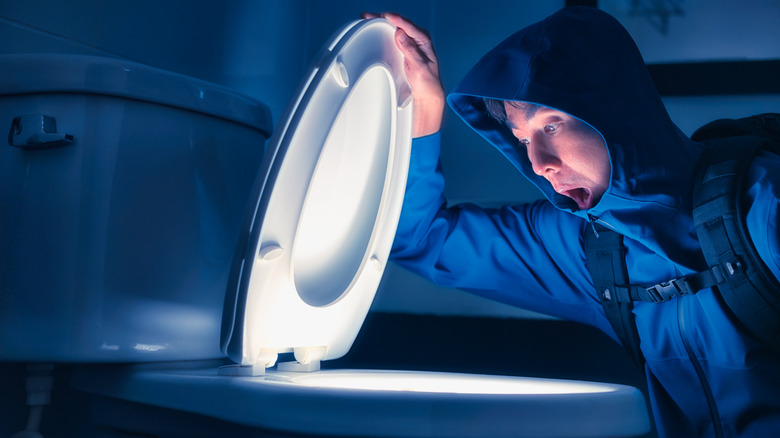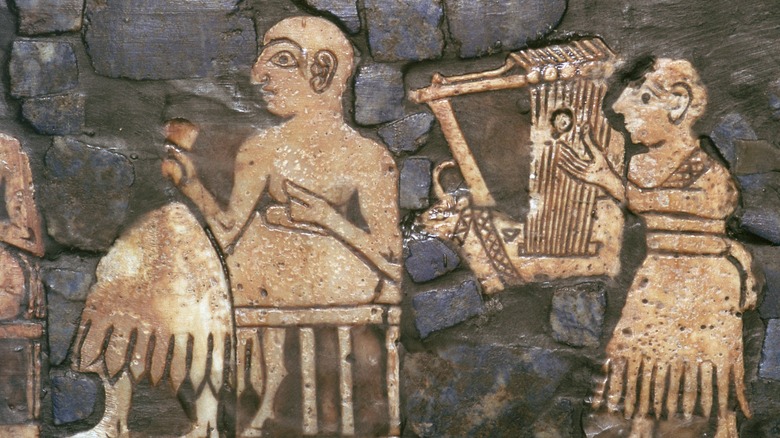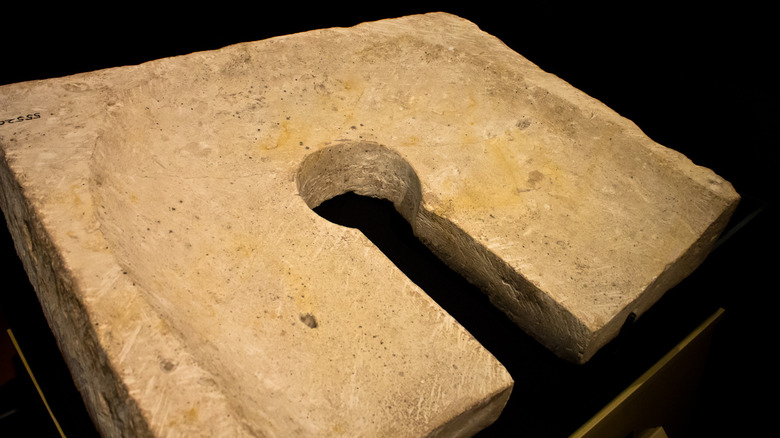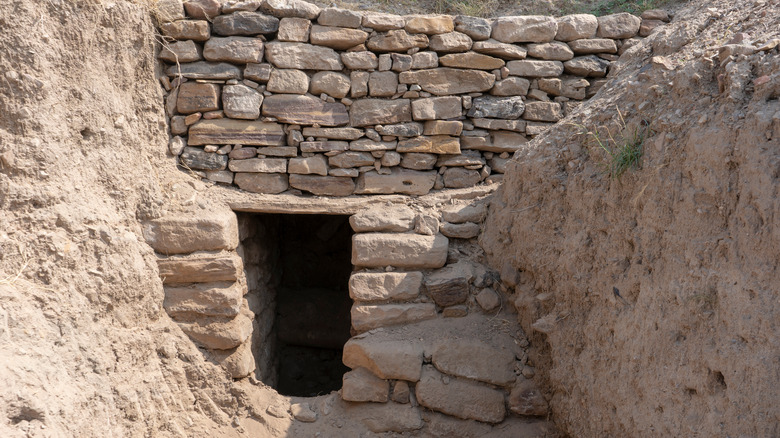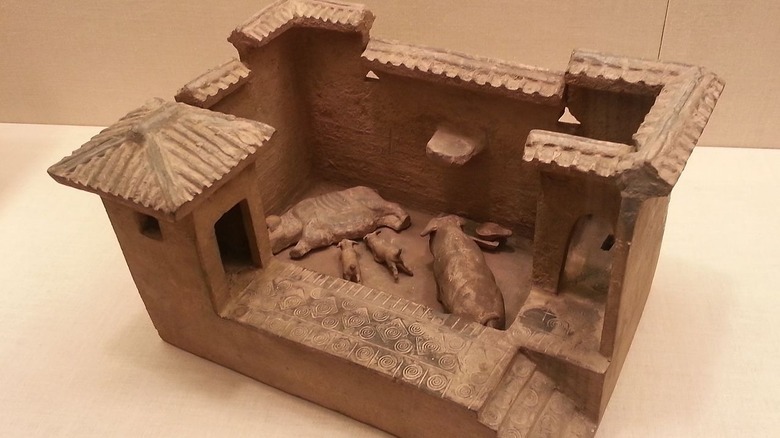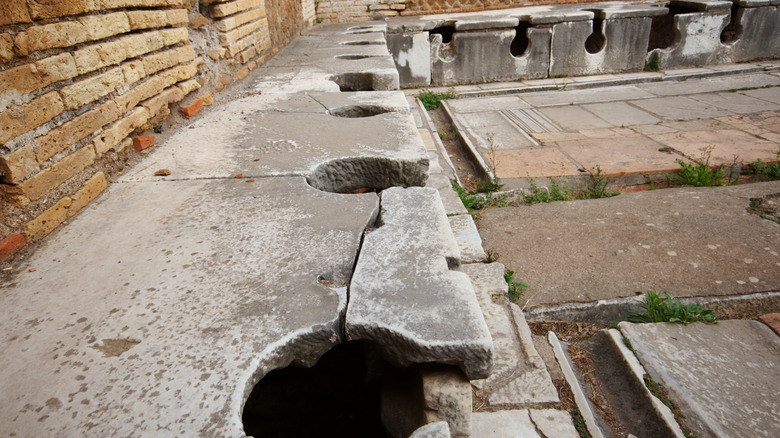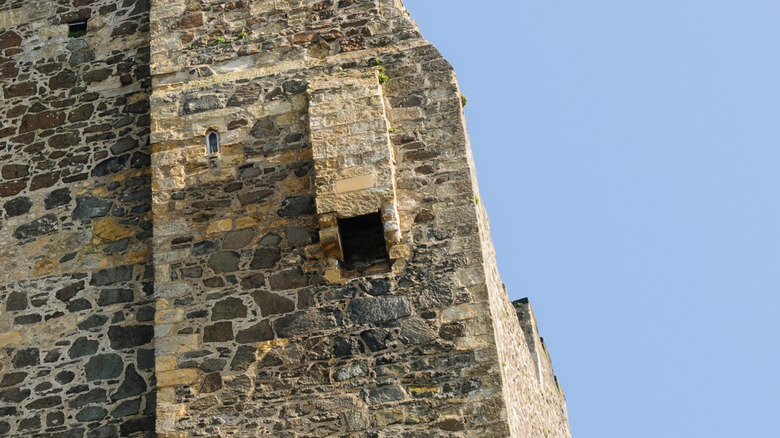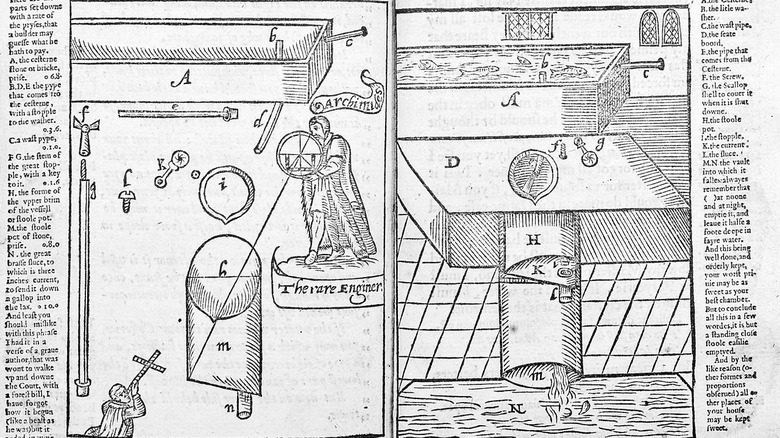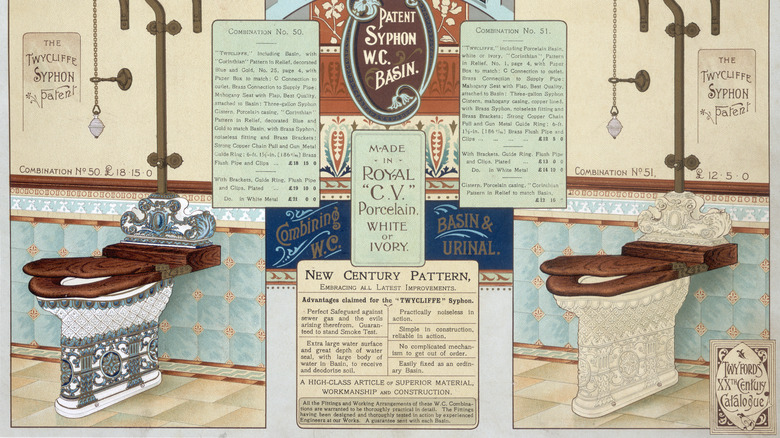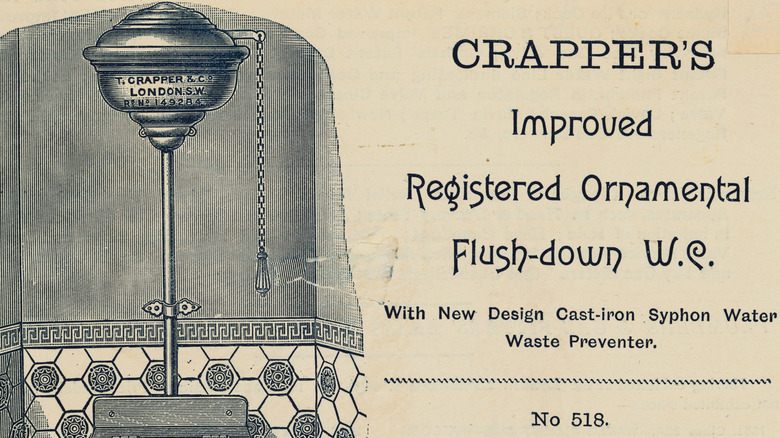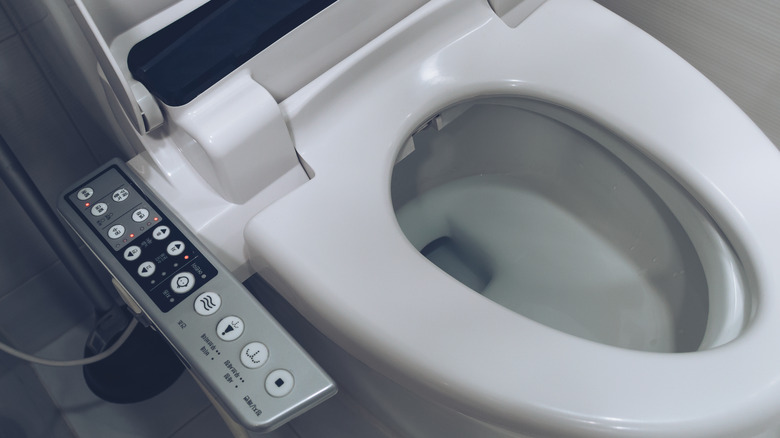The Untold History Of Toilets
Benjamin Franklin once said, "In this world, nothing is certain except death and taxes." He could well have added "... and using the toilet." Is there nothing more ubiquitous or vital to today's modern lifestyle than the restroom?
The toilet as it is flushed today is attributed to a 1775 invention by Alexander Cummings, but its history goes deeper than the deepest septic tank. In fact, there are many largely untold twists and turns in toilet lore, mainly because serious historians have long eschewed the topic.
Before stepping into it (well, hopefully not), let's define "toilet," since it may mean different things to different people. For example, a toilet to NASA might be worth a $25 million contract (per GovTribe). Or, to the aesthetically-minded Hang Fung Gold Technology Group in Hong Kong, a porcelain throne is really solid gold. These toilet extremes aside, let's use the simplest definition: A toilet is a fixed receptacle for human waste. So pinch a clothespin on your nose and dab yourself in perfume as we plunge away at some untold toilet history. You are duly warned that you may get a little grossed out.
Mesopotamian toilets leaked on purpose
Toilets are a feature of civilization, and the evidence for this is that the very first civilization used them — albeit sparingly. Ancient Near East Today states that the ancient Mesopotamians used toilets as far back as the third millennium B.C. These toilets were basic affairs, consisting of a deeply buried cylinder situated under a seat.
What may be surprising to us modern folks about these toilets is that few people possessed them: Archaeologists estimated that less than half of all houses in Mesopotamian cities featured one. This would have been problematic for ancient urban life since, to see any large-scale hygienic benefits from toilets, they must be installed in at least 75% of households. So why did so few houses have them? It may be because it was an individual's responsibility to arrange for their waste to be removed.
Another question as open as a Mesopotamian sewer is what the people would have done once the collection receptacles were full. Were they cleaned out or buried? One little-known detail may provide the answer: The cylindrical repositories had perforations. This is akin to owning a leaking septic tank, but on purpose. But why? One well-thought reason was provided by Piers Mitchell in his aptly named work, "Sanitation, Latrines and Intestinal Parasites in Past Populations." He suggests that Mesopotamians may have used the toilets for liquid waste only, and saved number twos for a separate, emptiable pot.
Ancient Egypt built toilets for the dead
Ancient Egyptian toilets were standard affairs in terms of design. Limestone lid ... check. Standard pot receptacle ... check. Keyhole-shaped opening for comfort ... check. But some rather disconcerting differences placed ancient Egypt on the toilet history map.
Egyptians typically used more widely available sand instead of water as the toilet's medium. Maybe it was because the ancient Egyptians worshiped cats, but they really elevated the idea of kitty-litter to a whole new level. Since those who possessed toilets were well-to-do, it can safely be assumed that the dirty job of scooping out the sandy litter belonged to a servant.
An intriguing aspect of Egyptian toilet culture is that the finest toilets were reserved for the dead. Karen Mutton writes in "Water Realms" that the pyramid complex of King Sahure, dating to about 4,500 years ago, featured tombs with lavatories complete with fancy copper piping. Since the ancient Egyptians believed that the afterlife was similar to the living world, it is perhaps unsurprising that the pharaonic tombs received the best sanitation. Assuming that the pyramid builders did not use the toilets as modern construction workers use porta-potties, or that there were really disrespectful archaeologists/tourists millennia later, it is safe to assume that these toilets have gone unused.
[Featured image by ddenisen (D. Denisenkov) via Wikimedia Commons | Cropped and scaled | CC BY-SA 2.0]
The Indus Valley civilization loved toilets
Today, at least in economically advanced nations, it's taken for granted that there are toilets in every house, but in most ancient homes you'd be lucky to get a pot to you-know-what in. But if you really wanted to find the finest toilet tech of the ancient world, then you needed to swing by the Indus Valley on the Indian subcontinent. Many of the details regarding Harappa — the name for the Indus Valley civilization that existed from the third to second millennium B.C. — is still a mystery. But one thing that is clear is that these people loved their toilets more than anybody else in the Bronze Age.
Harappan cities featured lots of toilets. According to Jonathan Mark Kenoyer and Kimberley Heuston's "The Ancient South Asian World," nearly all houses in the ruins of Mohenjo Daro and Harappa possessed toilets. What is more, Harappan toilets were well-situated. According to "Environmental History of Water," toilets were placed on the street side for easy waste disposal into a gutter.
This certainly demonstrates how the people of the Indus Valley were dedicated to public sanitation, centuries before any other people, including one notable detail; they flushed their toilets. Back then, there was no lever or chain. Instead, you'd use a bucket of water and pour it down the toilet when done. Perhaps not as sophisticated as modern flushing toilets, but it does make the Harappans one of the first people to ever enjoy the pleasures of washing waste down the drain.
Minoan toilets were in inappropriate places
For convenience, the Minoans of the island of Crete situated their toilets in places most people today wouldn't consider appropriate, much less hygienic. The Minoans, whose civilization peaked from about 2000 to 1400 B.C., were light years ahead in toilet technology. For example, they were among the first people to flush toilets using pots of water. Still, the average Minoan did not have a toilet. According to "The Evolution of Sanitation and Wastewater Technology Through the Centuries," most sites in the Minoan civilization, even the palaces, did not feature latrines. This evidence has led experts to believe that Minoans did not see toilets as essential.
There is a big but here. Those Minoans who had toilets apparently thought they needed to be as conveniently located as possible. Even the most savvy toilet-history connoisseur may not know that Minoan toilets were quite literally plopped in the living room. Granted, toilets were placed discreetly off to the side, but one may imagine that social engagements became awkward fast.
Dynastic China had pig toilets
One recent discovery in China may have rewritten latrine history. In 2023, China Daily reported that archaeologists had uncovered a 2,400-year-old flush toilet in the ruins of Yueyang. The toilet, which required water to be poured down it after every use, was apparently a luxury item (being the only ancient flush toilet ever found in China), but it does put this artifact into contention as one of the world's earliest flushing toilets. The archaeologists uncovering the site expressed even more excitement at the prospect of analyzing preserved human waste, in order to gain insights into the lifestyles of the ancient Chinese.
As noted, throughout most of Chinese history, flushing toilets weren't on tap, and people devised other kinds of toilets. A common toilet type used for thousands of years and well into the 20th century was the pig toilet. No, these weren't for the pigs — they were latrine structures built over a pigsty. Without going into too much detail, the output of the toilet provided sustenance for the livestock. The association of pigs and toilets is so entwined that, as Nissim Amon writes in "Chinese for Beginners," the Chinese characters for "pig" and "toilet" are closely related.
[Featured image by Rhododendrites via Wikimedia Commons | Cropped and scaled | CC BY-SA 4.0]
Roman toilets could kill you
The Romans are renowned for their waterworks and sanitation projects, including monumental aqueducts, public baths, and public toilets. And like today, the last place you'd want to relieve yourself in the Roman Empire was a public restroom. But there are more compelling reasons to avoid a Roman latrine over one you'd find off an interstate today.
Roman toilets offered no privacy. Public restrooms consisted of open benches with toilet seats over pipes that shot straight into the sewer. Maybe the lack of privacy wasn't a big issue since, as Nature points out, the Romans wore flowing togas. Once you did your duty and had to clean yourself, you didn't use toilet paper. Instead, people cleaned themselves with a stick topped with a sea sponge called the tersorium, which meant "wiping thing." When done, you replaced the tool in a bucket of water or vinegar convenient for the following toilet patron.
Perhaps worst of all was that while you sat on the toilet, you had to worry about many hidden dangers below you. The Romans did not have U-bends in their sewer pipes, so there was direct communication with the sewer. Discover Magazine describes how vermin of all kinds could creep up on unsuspecting victims who were at their most vulnerable. Also, because of the concentrated waste, methane gas built up, leading to the risk of sudden explosions. It was routine for people to pray to goddess Fortuna before entering a public latrine.
Medieval armies used toilet tactics
To the popular imagination, or at least to those who may imagine about such things, medieval Europe was the dark age of the toilet. However, this is not entirely the case. According to Paul B. Newman in "Daily Life in the Middle Ages," clergy and nobility had access to toilets. Those used in castles were called garderobes, a term that came to mean wardrobe or changing room, though this was not their original purpose.
Garderobes were communal latrines in towers centered about a shaft, from which human waste dropped into the moat or a pit. To keep the air clear, inhabitants burned fires all year round to improve ventilation with rising hot air. More unusual were the variety of garderobes situated on the outer walls, from which waste did not fall down a shaft, but directly down the outsides of the walls into a ditch or moat. One walking close by would have been very wary of an aerial bombardment.
Garderobes also benefited besieging armies. The World History Encyclopedia recounts how in the early 13th century, besiegers at Chateau Gaillard used garderobe shafts to penetrate the castle. This tactic was a clever exploitation of the fortress's weak point, although the soldiers who carried out the assault probably did not appreciate the commander who conceived it.
The inventor of the first modern flushing toilet was banished
The English Renaissance was a high point in British history, featuring luminaries such as Sir Francis Bacon, John Milton, and William Shakespeare. But most people don't know of Sir John Harington, who did more for a civil and happy society, in a practical sense, than these giants by inventing the modern-style flushing toilet.
Harington was a courtier in the court of his godmother Queen Elizabeth I and known for racy writing, which resulted, on one occasion, in banishment. During this downtime, he conceived of his great invention, "Ajax," a mechanical flushing toilet. The name was connected to the similarly pronounced "Jakes," slang for toilet. Good Queen Bess allowed Harington to install one in her palace in Richmond in 1592, though it is unknown whether she was excited about it.
However, Harington himself was ever the enthusiast, and wrote about his invention in his 1596 satirical poem "A New Discourse on a Stale Subject, The Metamorphosis of Ajax." It even included a detailed diagram. Regrettably, for Harington, his treatment of the subject matter was considered obscene, and he was again banished from court. History has vindicated Harington as a visionary far ahead of his time, even though toilet technology was doomed to recede into a dark age for another two centuries.
Early modern toilets were pay per flush
The 1851 Great Exhibition in London is a seminal event in modern toilet history. There, multitudes of Victorians were awed as they enjoyed the marvelous new technology of pulling a chain to watch their most private affairs drain away. But there was a catch.
While ardent lavatory enthusiasts may know about the toilet's grand reveal, many may not know that you had to pay for the pleasure. The Royal Parks explains that attendees forked over a penny, and in return, they not only got to use the toilet, but they received a towel, comb, and a bonus shoe shine. While it isn't noted if users got to pull the chain more than once for the penny, we do know that an incredible 675,000 pennies were collected. While not as common today, there are still plenty of pay-per-use restrooms throughout the world — though these days, it probably doesn't include a shoeshine.
While the Great Exhibition popularized toilets, it unexpectedly made urban blight worse. While the use of toilets generally improves city sanitation, London's system was unfortunately undersized to handle the inflow of additional human waste. This led to such situations as the Great Stink of 1858. Only when a proper sewer system was put in place in 1868 did the new flushing toilets take off.
Earth closets were once contenders for top toilet
By the mid-19th century, cities like London had become cesspits of diseased filth. Toilets were being adopted, but because the sewer system could not handle the additional waste, it just added to urban misery. In 1860, Reverend Henry Moule stepped in with his patented solution — the earth closet.
Instead of running water sloshing out the you-know-what, human waste was covered up with dirt and composted. Moule crowed about its incredible ability to suppress odors. In 1868 the concept hopped across the pond to the United States, where Moule received a separate American patent. Copycat patents followed as other human waste engineers thought the earth closet a marvelous idea.
But earth closets never really took off. The problem seemed to do with maintenance issues, since the dirty soil needed removal and replacement as often as once a day. In cities, pristine dirt was less available, and besides, there was no viable place to dispose of it. Just as importantly, the market hype didn't live up to the reality — earth closets smelled pretty bad. However, while earth closets have been largely now replaced by flushable toilets, there are still some places in the world that use these dry-type, composters where regular plumbing isn't available.
The Thomas Crapper myth flushed
There is a persistent historical myth that Thomas Crapper, who lived from 1836 to 1910, invented the toilet as we know it. The Crapper myth has long been debunked as well ... crap. The false claim he invented the flushing toilet stems from a 1969 book entitled "Flushed with Pride: The Story of Thomas Crapper" by Wallace Reyburn.
But, if Crapper did not invent the toilet, he certainly made some monumental, although relatively untold, contributions to toilet history. He was a master marketer who owned a marvelous bathroom showroom. He also held some essential toilet patents such as the floating ballcock. Without this wee piece of hardware, toilets would regularly overflow as they filled up. His toilet innovations did not stop there. He even made the first automatic flushing toilet, which worked when a person stood up from the seat.
The truth is that Crapper's brand was seen by American soldiers who were in the U.K. during World War I. Since to them, "crap" was a word that meant offal or garbage, the Americans were very much amused to see the name on a toilet. This imparted to "crap" its much more specific and contemporary meaning.
Modern toilets can tell you when to go to the hospital
The world is on the cusp of an age where the toilet will once more lead a rear-end revolution. Since the early 20th century, the way toilets work has mainly remained the same. Sure, there are ones that have heated seats and motion sensors, some which spray your butt, and even others that blow hot air — but there hasn't been a game-changing toilet tech since Victorian times. That is, until now. Latrine innovators are constantly pressing the envelope for new features to enhance one's restroom journey. This has created toilets that are maybe a bit ... too invasive.
For example, Stanford Medicine reported in 2020 that smart toilets are in the pipeline. These wonders of modern technology can sample your waste and send your data to the cloud, where computers analyze the sample to inform you about any diseases and other serious conditions they detect. The developers of this toilet explained that it was like a smartwatch, but unlike a watch that you can remove and forget to put back on, a toilet is non-negotiable: You have to use it. Enthusiasts believe that the toilet of the future could be the ultimate way to monitor your health, and may even give you some frank advice – such as to eat a bit more fiber.
